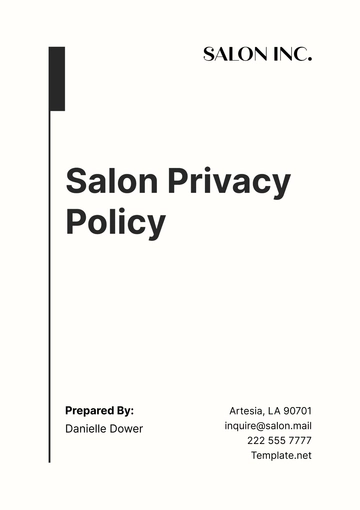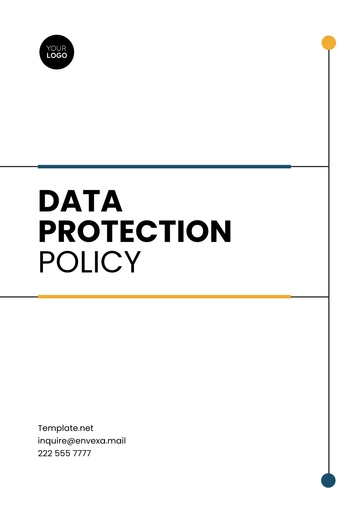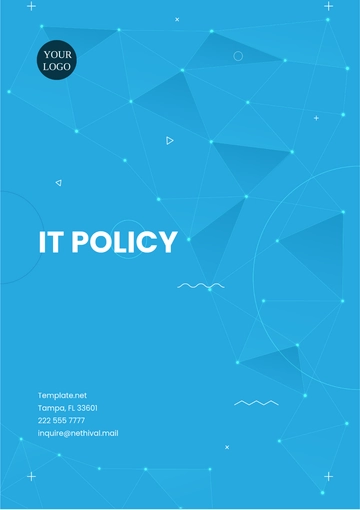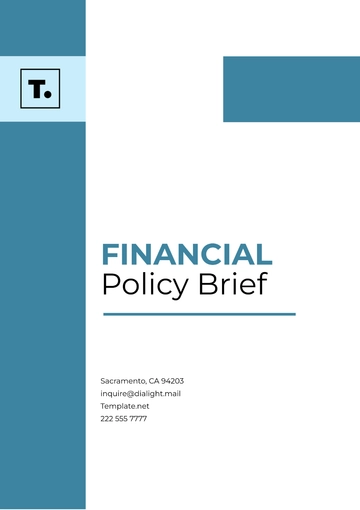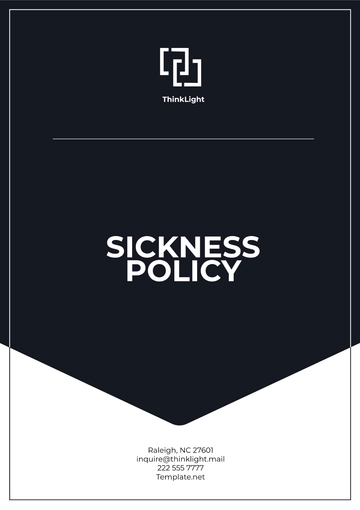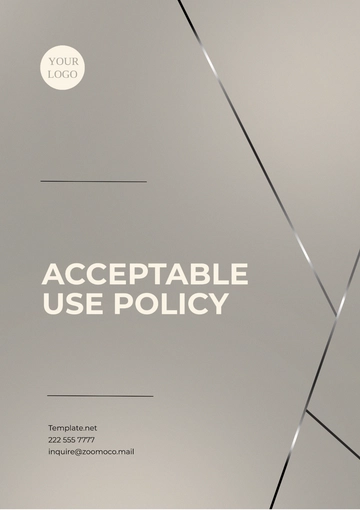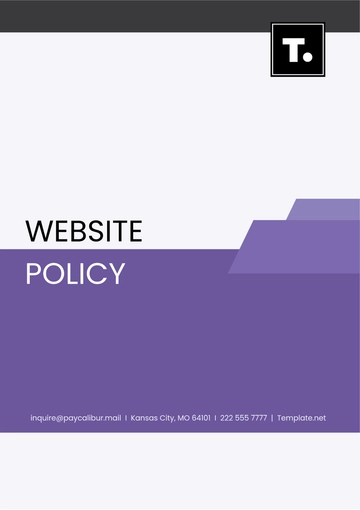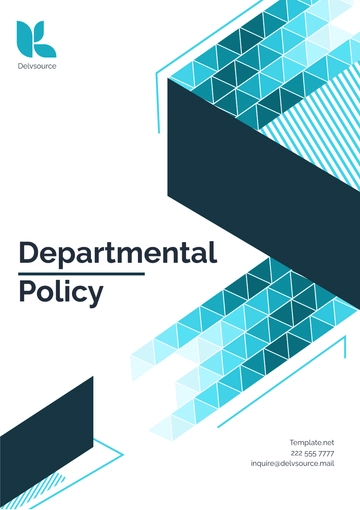Free Climate Change Policy
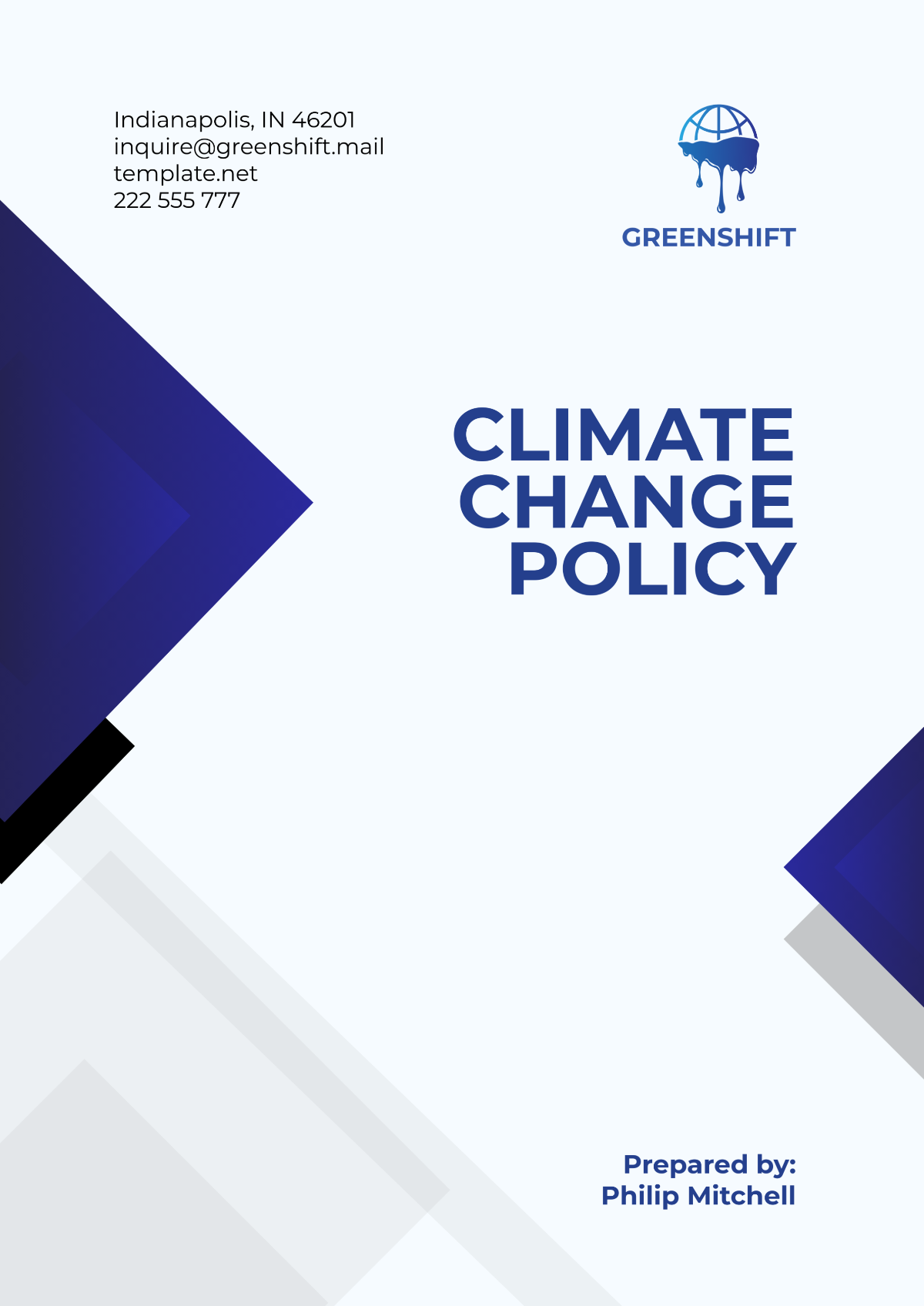
Introduction
Climate change is one of the greatest challenges humanity has ever faced, affecting ecosystems, economies, and communities worldwide. In response to this global crisis, [Your Company Name] is committed to implementing policies and practices that mitigate climate impacts, reduce our environmental footprint, and contribute to a sustainable, resilient future. Our goal is not only to ensure compliance with climate-related regulations but also to take proactive steps that go beyond regulatory requirements, focusing on long-term strategies that create positive change for both our business and the world at large. As the global climate continues to shift, it is imperative for organizations to act now to address the environmental and societal challenges we face.
This Climate Change Policy sets out our comprehensive approach to reducing greenhouse gas (GHG) emissions, enhancing climate resilience, and contributing to community sustainability. By [2050], we aim to achieve net-zero emissions and take a leadership role in promoting environmental responsibility across all aspects of our operations and supply chain. This document provides detailed action plans, targets, and strategies for addressing climate change, including both mitigation and adaptation efforts.
1. Objectives
1.1. Mitigation
Mitigation refers to actions aimed at reducing or preventing the emission of GHGs. [Your Company Name] recognizes the urgency of minimizing our carbon footprint, as these emissions are the primary drivers of global warming and climate change. To fulfill our commitment to a sustainable future, we have set ambitious targets, with the ultimate goal of achieving net-zero emissions by [2050]. This will be achieved through a combination of energy efficiency, the adoption of renewable energy sources, and innovations in carbon capture technology.
Reduction in GHG Emissions: We are targeting a reduction in emissions by [25%] by [2025], [50%] by [2060], and [75%] by [2070], with a complete shift to net-zero by [2050]. These reductions will occur through the optimization of energy use, reduction in waste, and the transition to cleaner energy solutions.
Energy Efficiency: Energy efficiency is a cornerstone of our mitigation efforts. We are committed to reducing our energy consumption by [30%] by [2060] through the installation of energy-efficient lighting, heating, and cooling systems across all facilities. Additionally, we will encourage energy-efficient behavior among employees, contractors, and stakeholders.
Sustainable Supply Chain: The environmental impact of our supply chain is a key area of focus. By [2060], we aim to reduce supply chain emissions by [40%] by collaborating with suppliers to implement sustainable practices, sourcing materials with lower carbon footprints, and transitioning to low-emission transportation methods.
1.2. Adaptation
While mitigation efforts are essential in reducing future emissions, adaptation strategies are equally critical in addressing the current and anticipated impacts of climate change. [Your Company Name] understands the importance of building resilience to the changing climate and ensuring that both our infrastructure and operations can withstand climate-related disruptions.
Climate Resilience: We will invest in climate-resilient infrastructure, ensuring that all new construction projects incorporate measures to withstand extreme weather events such as flooding, heatwaves, and storms. By [2065], all facilities will meet the latest climate-resilient standards set by global frameworks, ensuring that our operations are protected from the impacts of climate change.
Risk Assessment: Regular climate risk assessments will be conducted to identify vulnerabilities and evaluate the potential impact of climate change on our business. These assessments will inform our strategic decisions, guiding investments in adaptation measures and ensuring that our business continuity plans are robust and effective.
1.3. Community Engagement
Climate change affects not only businesses but also the communities in which they operate. [Your Company Name] is committed to engaging with local communities and stakeholders to promote climate resilience, raise awareness, and foster collective action in the fight against climate change.
Public Awareness: We will actively engage with the public through climate awareness campaigns aimed at educating individuals on the importance of reducing their carbon footprints. This includes community workshops, online resources, and partnerships with schools and universities to foster the next generation of environmental leaders.
Partnerships: Collaboration is key to addressing the global scale of climate change. [Your Company Name] will partner with governments, non-governmental organizations (NGOs), and other corporations to support large-scale initiatives that promote climate action. These partnerships will focus on reforestation, renewable energy development, and climate adaptation projects.
2. Climate Change Strategy
2.1. Emissions Reduction Plan
[Your Company Name] has created a clear and actionable plan for reducing its GHG emissions across all aspects of its business operations. By [2050], we will have reduced our emissions to net-zero. This strategy will be carried out in stages, with specific milestones set for the next few decades. The plan is built on energy efficiency, renewable energy adoption, and carbon removal strategies.
Year | Emissions Reduction Goal (% Reduction) | Key Actions |
|---|---|---|
2050 | 25% | Transition to [50%] renewable energy usage, reduce operational emissions. |
2055 | 50% | Electrify vehicle fleets, implement energy-efficient processes across all operations. |
2060 | 75%] | Full-scale deployment of carbon capture technologies, shift to circular economy principles. |
270 | 100% | Achieve net-zero emissions, ensuring all operations are carbon-neutral. |
Our plan includes several key initiatives:
Transitioning to Renewable Energy: By [2050], [Your Company Name] will source [50%] of its energy from renewable sources, including solar, wind, and hydropower.
Energy Efficiency: Reducing energy consumption is a critical part of our strategy, with a focus on optimizing building systems, upgrading equipment, and utilizing energy-efficient technologies.
Carbon Capture and Storage: We will invest in emerging technologies such as carbon capture and storage (CCS) to remove excess carbon from the atmosphere and store it safely.
2.2. Renewable Energy Adoption
As part of our commitment to reducing GHG emissions, we will transition to renewable energy sources. By [2050], all our operations will be powered entirely by renewable energy.
Solar Power: By [2055], we will install solar panels on all rooftops and available land at our facilities, with an estimated capacity of [500 MW]. This will provide [30%] of our total energy needs.
Wind Energy: We will enter into long-term power purchase agreements (PPAs) with wind farms to secure renewable energy. By [2060], [Your Company Name] will source [60%] of its energy from wind power.
Hydropower: For regions with abundant water resources, hydropower will provide a reliable and sustainable energy source. We will invest in local hydropower plants to power our operations in these areas.
2.3. Waste Management
A key component of our sustainability efforts is reducing waste and ensuring that it is managed in an environmentally responsible manner. By [2065], we aim to achieve zero waste to landfill. This will be accomplished through:
Recycling Programs: [Your Company Name] will implement recycling programs across all facilities, targeting an increase in recycling rates to [85%] by [2060]. This will include separating materials such as paper, glass, metal, and plastics for recycling.
Composting Initiatives: Organic waste, such as food scraps and yard waste, will be composted at all locations, reducing the amount of waste that ends up in landfills and returning nutrients to the soil.
Product Recycling: We will also focus on encouraging our customers to recycle products by providing buy-back programs, offering discounts on future purchases in exchange for old products, and promoting take-back schemes.
3. Sustainable Business Practices
3.1. Supply Chain Sustainability
At [Your Company Name], we recognize that our environmental impact extends beyond our operations to the suppliers we work with. Therefore, we are committed to ensuring that sustainability is integrated across our entire supply chain.
Engage Suppliers: We will collaborate with suppliers to reduce emissions and minimize waste throughout the supply chain. By [2055], [75%] of our suppliers will adhere to sustainable practices and meet our environmental standards.
Green Logistics: Transportation accounts for a significant portion of our emissions. We will work to minimize emissions from transportation by optimizing delivery routes and transitioning to electric vehicles and low-emission shipping options. This will reduce transportation emissions by [40%] by [2060].
Local Sourcing: We will prioritize sourcing materials locally to minimize transportation distances and reduce the carbon footprint of our products. By [206], we aim to source [75%] of materials from local suppliers.
3.2. Product Lifecycle Assessment
Our commitment to sustainability extends to the full lifecycle of our products. From design and manufacturing to disposal, we aim to minimize the environmental impact of all our products.
Eco-friendly Design: All new products will be designed with sustainability in mind, using recyclable materials and reducing waste throughout the manufacturing process. We aim to achieve [80%] product recyclability by [2060].
Consumer Responsibility: We will implement buy-back programs and provide consumers with information on how to recycle products at the end of their life cycle, helping to close the loop in our products’ lifecycle.
4. Climate Risk Management
4.1. Risk Assessment Framework
Effective climate risk management is integral to [Your Company Name]’s long-term sustainability. We regularly conduct climate risk assessments to understand the potential impacts of climate change on our business operations.
Risk Category | Potential Impact | Mitigation Strategies |
|---|---|---|
Physical Risks | Damage to infrastructure, supply chain disruptions | Invest in resilient infrastructure, diversify supply chain sources |
Regulatory Risks | Compliance with emerging climate policies | Stay ahead of regulations, align with global climate agreements |
Market Risks | Consumer shift to sustainable products | Develop a portfolio of eco-friendly products, engage in market research to understand trends |
Through comprehensive risk assessments, we ensure that all potential climate-related disruptions are identified and managed accordingly.
4.2. Contingency Planning
Building resilience is vital to ensuring that [Your Company Name] can continue operations in the face of climate impacts. We will develop and implement disaster preparedness plans that address the unique risks posed by climate change.
Disaster Preparedness: Our contingency plans will include specific strategies for dealing with extreme weather events, such as hurricanes, wildfires, and heatwaves. Facilities located in high-risk areas will be retrofitted to withstand these events, ensuring minimal disruption to operations.
Insurance Coverage: [Your Company Name] will expand its insurance coverage to protect against climate-related risks, ensuring that we have the financial resources needed to recover from potential disruptions. This includes coverage for facilities, supply chains, and inventories that may be impacted by extreme weather events.
5. Community and Stakeholder Engagement
5.1. Awareness Campaigns
Raising awareness about the importance of climate change and the role that businesses, governments, and individuals play in mitigating its impacts is central to [Your Company Name]'s strategy. We understand that achieving meaningful change requires the active participation of all stakeholders, from employees and suppliers to customers and local communities. By engaging with the public, we can promote a collective mindset that prioritizes sustainability and climate resilience.
Workshops and Training: In partnership with local organizations, we will host a series of educational workshops designed to provide community members with the tools and knowledge needed to take climate action in their daily lives. These workshops will focus on topics such as energy efficiency, waste reduction, and sustainable agricultural practices. Workshops will be tailored to various groups, including schools, local businesses, and households, ensuring that the content resonates with the unique needs and challenges of each group.
Youth Engagement: Fostering a generation of environmentally-conscious leaders is crucial to long-term climate action. We will implement programs in schools that educate students about the science of climate change, the importance of sustainability, and how they can contribute to a healthier planet. Through partnerships with educational institutions, we aim to create a curriculum that integrates environmental sustainability and climate science into standard education practices. This will include organizing eco-friendly challenges, sustainability fairs, and providing internships and career mentorship in green industries.
Digital Outreach and Social Media: We will leverage digital platforms to disseminate climate-related information widely. Our social media presence will be used to share updates on [Your Company Name]’s sustainability initiatives, climate change news, and tips for individuals and businesses to reduce their environmental footprints. Through engaging content such as infographics, videos, and interactive posts, we will build a broader online community focused on sustainable living. Additionally, we will host online webinars and Q&A sessions with climate experts to provide people with insights into current climate challenges and solutions.
5.2. Collaboration with Governments and NGOs
Collaboration with governments and non-governmental organizations (NGOs) is essential to the success of global climate efforts. [Your Company Name] is committed to actively participating in public-private partnerships that address the multi-faceted nature of climate change. By working with stakeholders from different sectors, we can pool resources, expertise, and influence to create larger-scale, more impactful solutions.
Policy Advocacy: [Your Company Name] will engage in advocacy for stronger climate change policies at local, national, and international levels. This includes lobbying for carbon pricing mechanisms, promoting the implementation of renewable energy standards, and advocating for stricter regulations on emissions. Our company will work closely with policymakers to shape climate legislation that incentivizes businesses to adopt sustainable practices while ensuring that disadvantaged communities are supported in the transition to a low-carbon economy.
International Cooperation: Climate change is a global problem that requires global solutions. [Your Company Name] will engage in international climate initiatives such as the Paris Agreement and other global accords aimed at limiting global temperature rise. We will collaborate with other corporations, NGOs, and governmental bodies to fund large-scale renewable energy projects, reforestation efforts, and climate adaptation programs in regions vulnerable to climate impacts. This also includes helping to implement the United Nations Sustainable Development Goals (SDGs), particularly Goal 13: Climate Action.
Community Projects: We will allocate [$5 million] annually to fund climate-resilient community projects. These projects will focus on addressing local environmental challenges such as deforestation, water scarcity, and access to clean energy. The funds will be directed to initiatives such as the installation of solar energy systems in off-grid rural communities, developing drought-resistant agriculture practices, and supporting the development of sustainable transportation options. By directly investing in local communities, we can help them adapt to climate change while promoting broader environmental benefits.
6. Monitoring and Reporting
6.1. Performance Metrics
To ensure that our climate change goals are being met and to track our progress over time, [Your Company Name] will develop a set of clear and measurable performance metrics. These metrics will serve as benchmarks for monitoring our environmental impact and will be reviewed regularly to ensure we stay on track to achieve our climate targets.
Metric | Baseline (2050) | Target ([2060]) |
|---|---|---|
Carbon Emissions (tons) | 1,000,000 | 0 |
Renewable Energy Usage | 20% | 100% |
Waste Recycling Rate | 50% | 85% |
Water Usage (gallons) | 1,000,000 | 50% reduction |
Percentage of Green Suppliers | 20% | 75% |
These performance indicators will allow us to assess the effectiveness of our climate strategies and ensure that all parts of our organization are making meaningful contributions to environmental sustainability. Each metric will be linked to specific initiatives, such as the transition to renewable energy, waste reduction, and emissions control, and progress will be assessed annually.
Carbon Emissions Reporting: Carbon emissions data will be collected from all our operations, including our supply chain, and aggregated into a company-wide emissions report. This data will be shared publicly to demonstrate transparency and accountability in our sustainability practices.
Energy Use and Waste Monitoring: We will monitor energy consumption and waste generation at each facility, identifying opportunities to further reduce both. Key actions to optimize energy use include retrofitting buildings with energy-efficient systems, installing motion sensors for lighting, and upgrading machinery to more energy-efficient models. Waste monitoring will help us identify opportunities to minimize single-use plastics, increase recycling, and reduce landfill contributions.
6.2. Reporting Framework
To maintain transparency and ensure that our stakeholders are fully informed of our progress, we will implement a comprehensive reporting framework. [Your Company Name] will publish detailed sustainability reports annually, documenting the progress we have made towards our climate change goals, along with any challenges we have encountered. These reports will be publicly available on our website and will be shared with investors, customers, and the general public.
Annual Sustainability Reports: The reports will provide a comprehensive review of our environmental performance, highlighting key achievements, such as GHG reductions, energy savings, and waste reductions. The reports will also include detailed information on the impact of our initiatives, such as the number of renewable energy projects implemented or the volume of waste diverted from landfills. Additionally, we will use these reports to communicate any changes or updates to our climate change strategies and targets.
Third-Party Audits: To ensure that our climate-related claims are credible and that we are adhering to industry best practices, we will engage third-party auditors to assess our sustainability performance. These audits will focus on verifying emissions reductions, energy use, and waste management practices. Third-party verification adds credibility to our reports and assures stakeholders that our sustainability efforts are accurate and in line with global standards.
7. Financial Investments
7.1. Budget Allocation
The financial resources required to achieve our climate change goals will be substantial. [Your Company Name] is committed to investing heavily in sustainability initiatives, and we will allocate significant portions of our budget towards our environmental efforts. These investments will ensure that we can meet our emissions reduction targets, transition to renewable energy, and implement climate resilience projects.
Category | Budget ($) |
|---|---|
Renewable Energy Projects | 500 million |
Infrastructure Upgrades | 300 million |
Community Programs | 200 million |
Carbon Capture Technologies | 150 million |
Research & Development | 100 million |
The total amount allocated to our climate change initiatives by [2050] will exceed [$1.25 billion], reflecting the scale and ambition of our strategy.
Renewable Energy Projects: A significant portion of our budget will be allocated to renewable energy initiatives, including investments in solar, wind, and hydropower. These projects will reduce our reliance on fossil fuels and ensure that we meet our target of 100% renewable energy by [2050].
Infrastructure Upgrades: To achieve energy efficiency and climate resilience, we will invest in upgrading our facilities. This includes retrofitting buildings with energy-efficient technologies, improving water management systems, and ensuring that all facilities meet climate-resilient standards.
Carbon Capture Technologies: We will invest in the development and deployment of carbon capture technologies to help us remove CO2 from the atmosphere. These technologies will be critical to achieving our net-zero emissions target by [2050].
Community Programs: As mentioned earlier, we will allocate [$5 million] annually to support local and regional climate resilience projects. This funding will focus on initiatives that help communities adapt to the impacts of climate change, such as improved water management, sustainable agriculture, and renewable energy access.
7.2. Funding Sources
To finance our climate initiatives, we will explore several funding sources, ensuring a balanced approach that minimizes financial risks while maximizing the impact of our climate efforts.
Internal Revenue: We will dedicate [10%] of our annual profits to fund climate-related projects. This will ensure that sustainability remains a core part of our financial strategy and allow us to maintain momentum in our climate action efforts.
Green Bonds: We will issue green bonds to raise capital for renewable energy and environmental protection projects. These bonds will attract environmentally-conscious investors and provide us with the necessary funds to accelerate our transition to a low-carbon economy. By [2060], we aim to raise [$200 million] through green bond issuances.
Grants and Subsidies: We will actively apply for government grants and subsidies that support the development of green infrastructure and renewable energy projects. Many governments offer financial incentives to companies that invest in sustainability, and we plan to take full advantage of these opportunities to supplement our internal funding.
8. Future Commitments
8.1. Innovation and Technology
As technology continues to advance, [Your Company Name] will remain at the forefront of innovation, constantly seeking new and emerging technologies that can help us achieve our climate goals. Technological innovation will play a key role in reducing emissions, improving energy efficiency, and developing climate-resilient infrastructure.
Carbon Capture: We will continue to invest in next-generation carbon capture technologies, such as direct air capture (DAC) and bioenergy with carbon capture and storage (BECCS). These technologies have the potential to capture and store carbon at scale, helping us to offset emissions that are difficult to eliminate through other means.
Artificial Intelligence (AI): AI will play a crucial role in optimizing energy use across our operations. By using AI to analyze energy consumption patterns, we can identify inefficiencies and automate systems to reduce waste. Additionally, AI will help us design smarter, more efficient buildings and logistics systems, further reducing our environmental footprint.
Green Hydrogen: [Your Company Name] will explore the potential of green hydrogen as a clean fuel alternative for sectors such as transportation, manufacturing, and heavy industry. Green hydrogen is produced using renewable energy and offers a carbon-neutral solution for industries that are difficult to electrify.
8.2. Policy Advocacy
As part of our ongoing commitment to addressing climate change, we will continue to advocate for stronger climate policies that support both our business and the global community. Policy changes are essential for creating a level playing field, encouraging investment in clean energy, and accelerating the transition to a low-carbon economy.
International Agreements: We will work with international bodies to support climate policies that align with the Paris Agreement's target of limiting global temperature rise to 1.5°C. We will also advocate for ambitious carbon pricing mechanisms that encourage businesses to reduce their emissions.
Carbon Tax Advocacy: We support the implementation of carbon taxes, which have proven effective in incentivizing companies to reduce their emissions. We will engage in policy discussions with governments around the world to encourage the adoption of carbon tax frameworks that drive businesses toward sustainability.
- 100% Customizable, free editor
- Access 1 Million+ Templates, photo’s & graphics
- Download or share as a template
- Click and replace photos, graphics, text, backgrounds
- Resize, crop, AI write & more
- Access advanced editor
Create a strong climate change policy with the Climate Change Policy Template from Template.net. This editable and customizable template helps you define sustainable practices for your organization. Tailor it easily using the AI Editor Tool. Download today to establish your commitment to environmental responsibility.
You may also like
- HR Policy
- Restaurant Policy
- Company Policy
- Accounting Policies and Procedures
- Website Policy
- Privacy Policy
- Safety Policy
- School Policy
- IT and Software Policy
- Law Firm Policy
- Construction Policy
- Interior Design Policy
- Travel Agency Policy
- Education Academic Policy
- Security Policy
- Real Estate Policy
- Expense Policy
- Software Policy







